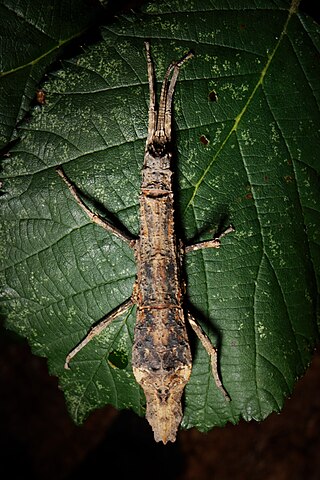
The Heteropterygidae is a family of stick insects belonging to the suborder Euphasmatodea. Species can be found in Australasia, East and Southeast Asia. About 150 valid species have been described.

Pylaemenes is a genus of stick insects in the family Heteropterygidae and subfamily Dataminae. It combines small to medium-sized, often brightly colored Phasmatodea species. Their representatives are found in large parts of Southeast Asia.

The genus Orestes combines relatively small and elongated Phasmatodea species from Southeast and East Asia.

The genus Microrestes combines relatively small and squat Phasmatodea species from continental Southeast Asia and South China.

Orestes dittmari is a species of stick insects in the subfamily Dataminae.

Orestes mouhotii is an insect species belonging to the order of Phasmatodea. Because of its synyonym Orestes verruculatus, it is the type species of the genus Orestes. Because of its compact body shape, the species is sometimes referred to as small cigar stick insect.

Orestes bachmaensis is a Phasmatodea species native to central Vietnam.

Orestes guangxiensis is a representative of the genus Orestes.

Orestes japonicus, a stick insect, is a representative of the genus Orestes.

Orestes krijnsi is a species of stick insects native to Vietnam.

Orestes subcylindricus is a species of stick insects native to Vietnam.

Orestes shirakii is a species of stick insects native to Taiwan.

Pylaemenes elenamikhailorum is a species of stick insects native in Sepilok on Borneo. In application of the more recent differentiation between the genera Pylaemenes and Orestes the species is sometimes also called Orestes elenamikhailorum.
Pylaemenes konkakinhensis is a species of stick insects native in Vietnam. The species is so far only known from a single female.
Orestes diabolicus is a species of stick insects native in Vietnam. The species is so far only known from a three males.
Orestes botot is a species of stick insects native in Vietnam.
Orestes ziegleri is a species of stick insect native to Thailand.

Pylaemenes konchurangensis is a species of stick insects native in Vietnam. The species has been described in the genus Pylaemenes, but from its morphological characters it belongs in the genus Orestes.

Microrestes robustus is a stick insect species native to northwestern Vietnam.

Eubulides timog is a stick insect species from the family of the Heteropterygidae. Although only described in 2023, this species, native to the south and east of the Philippine island Luzón, has been kept and bred in the terrariums of enthusiasts since 2009.





















